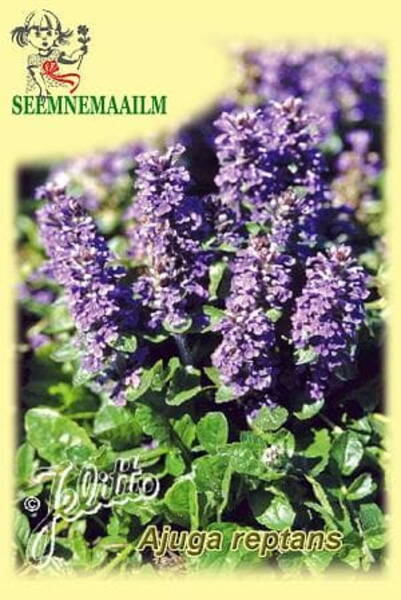A beautiful plant, very quickly forms a dense cover. Perennial. The plant is 15-20 cm high. It has strong creeping shoots and shiny dark green ovate leaves, serrated along the edge. Inflorescence-spike of dark blue, pink or white flowers, which alternate with leaf-shaped bracts. Blooms in late May - early June for 20 days. At this time, flower stalks rise 10-15 cm above the carpet. Does not give self-sowing. Winter hardy.
The most common in ornamental gardening are variegated forms and varieties of tenacious creeping, no more than 12 cm high.
It is used for container decoration, as a ground cover and ampelous plant in perennial compositions, good for large rocky gardens.
Agrotechnics.
The plant is characterized by high frost and winter hardiness, withstands spring and late autumn frosts. Unpretentious, but prefers a sliding shade and humus-rich, sufficiently moist soils. Propagated by sowing seeds before winter or early spring directly into the ground in a permanent place. Plants are thinned, maintaining a distance between plants of 20-25 cm. We recommend pre-sowing seed treatment and plant nutrition.
Location and soil: this extremely unpretentious ground cover is able to grow in any, even the most unfavourable conditions - in bright sun and in full shade, on light dry and heavy waterlogged lands. But still, a sliding shade and humus-rich, sufficiently moist loamy soils are preferable. The species is distinguished by high frost and winter hardiness, withstands spring and late autumn frosts, as well as short-term temperature drops to minus 8-10°C.
Care: regular fertilization in the spring is necessary. In dry weather, abundant watering. The uniqueness of the Ajuga reptans is that against the background of general greenery and rare silver of the ground cover, it creates elegant red-brown spots. For greater expressiveness and brightness of the carpet, it is advisable to remove the inflorescences, although they do not spoil the general appearance (as with some sedums). This, of course, does not apply to varieties with white and pink flowers, which give the plant a special charm.
Usage: so, if you like this very beautiful plant, where and how can you use it in the garden?
The Ajuga reptans is one of the few ground cover plants that grow well on the slopes and feels great among the stones and in the recesses between them, in curb plantings along the paths. The culture is very good for large rocky gardens (but not for cramped small rock gardens), as it quickly forms a dense cover. But in rock gardens, it is necessary to plant a survivor either away from valuable plants or to limit growth with the help of artificial synthetic materials.
You can use it for landscaping large areas with minimal maintenance, as well as in tree circles under trees and bushes. If you need to cover a piece of empty land on which a lawn cannot be arranged due to poor lighting, the best plant is hard to find.
It is also suitable for container design as a ground cover and ampelous plant in perennial compositions. If you are a novice gardener or you do not have extra time to care for the garden, start your acquaintance with ground cover with tenacity.
“If you are wise enough, the virtues of this plant will make you love it and you will always keep it with you.” (Nicols Kalpeper - English botanist).
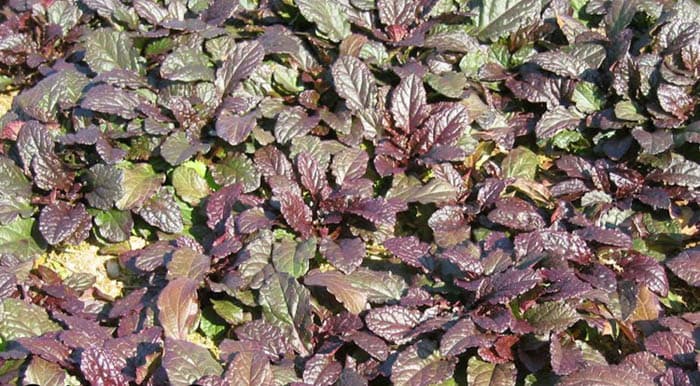
Officinal (medicinal) plant. Creeping, groundcovers. First year flowering.
V-VI, Z3-9, 15 cm.
Blue.
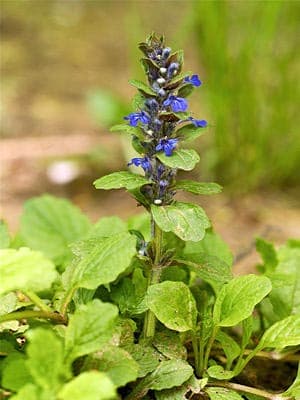
Physical Characteristics: An evergreen perennial growing to 0.3m by 0.6 m. It is hardy to zone 6 and is not frost tender. It is in leaf all year, in flower from May to July, and the seeds ripen from July to September. The flowers are hermaphrodite (have both male and female organs) and are pollinated by Bees and Lepidoptera (Moths & Butterflies). The plant is self-fertile. It is noted for attracting wildlife. We rate it 2 out of 5 for usefulness. The plant prefers light (sandy), medium (loamy) and heavy (clay) soils. The plant prefers acid, neutral and basic (alkaline) soils. It can grow in full shade (deep woodland) semi-shade (light woodland) or no shade. It requires dry moist or wet soil and can tolerate drought.
Habitats and Possible Locations: Meadow, Bog Garden, Woodland, Dappled Shade, Shady Edge, Deep Shade, Ground Cover.
Cultivation details: prefers a humus-rich, moisture-retentive soil and partial shade. Does well in marshy soil and in the spring meadow. Grows well in dry shade and is fairly drought tolerant once established, though it shows distress in severe drought. Plants do not always ripen their seeds in Britain, they spread freely by runners, however, and soon form an extensive patch in suitable conditions. Several forms have been selected for their ornamental value, several of which are variegated and are used especially as ground cover plants for dry shade. A purple-leafed form, Atropurpurea does well in full sun so long as the soil is not dry. A good bee and butterfly plant.
Propagation: Seed - sow spring or autumn in a cold frame. The seed usually germinates in 3 - 4 weeks at 10°C, though it can be erratic. Prick out the seedlings when they are large enough to handle and plant them out in the summer. Division of runners at almost any time of year. Very easy, the divisions can be planted straight out into their permanent positions if required. One of the best all-around groundcovers! Fast-growing, part to full shade, hardy to 40°C below zero F. (zone 2). Violet flower spikes in late spring to early summer. Plant on slopes, under trees or in poor soil -- will grow almost anywhere. Spreads rapidly, prevents weeds from cropping up and (last but not least) it is also deer resistant.
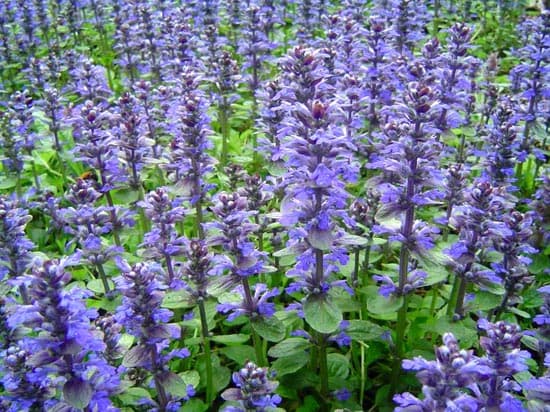
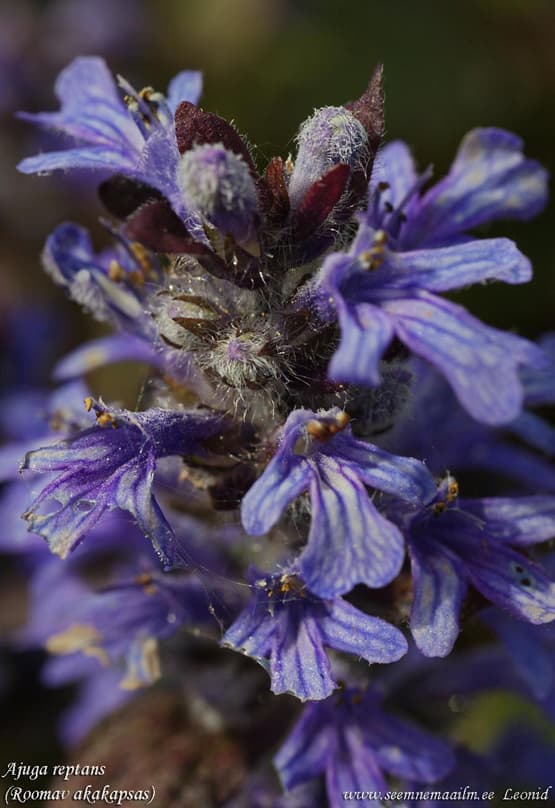
Сommon bugle, carpet bugleweed, carpenter's herb, mountain bugle.
Residents of Scandinavia and northern regions of Russia eat young leaves and shoots of bugleweed. The greens are used to prepare salads with the addition of potatoes, boiled eggs and vegetable oil. Finely chopped young bugleweed grass is stewed with onions and served as a side dish. Dried and ground into powder stems are added to flour, and soups and broths are seasoned with it.
* Bugleweed salad.
Wash fresh greens, chop, add finely chopped boiled potatoes, boiled eggs, season with vegetable oil and salt.
Bugleweed shoots - 200 g, potatoes - 2 pieces, egg - 2 pieces, vegetable oil and salt - to taste.






